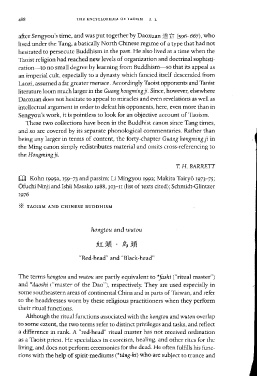Page 528 - The Encyclopedia of Taoism v1_A-L
P. 528
THE ENCYCLOPEDIA OF TAOISM A-L
after Sengyou's time, and was put together by Oaoxuan ill 11: (596-667), who
lived under the Tang, a basically North Chinese regime of a type that had not
hesitated to persecute Buddhism in the past. He also lived at a time when the
Taoist religion had reached new levels of organization and doctrinal sophisti-
cation-to no small degree by learning from Buddhism-so that its appeal as
an imperial cult, especially to a dynasty which fancied itself descended from
Laozi, assumed a far greater menace. Accordingly Taoist opponents and Taoist
literature loom much larger in the Guang hongmingji. Since, however, elsewhere
Oaoxuan does not hesitate to appeal to miracles and even revelations as well as
intellectual argument in order to defeat his opponents, here, even more than in
Sengyou's work, it is pointless to look for an objective account of Taoism.
These two collections have been in the Buddhist canon since Tang times,
and so are covered by its separate phonological commentaries. Rather than
being any larger in terms of content, the forty-chapter Guang hongmingji in
the Ming canon simply redistributes material and omits cross-referencing to
the Hongmingji.
T. H. BARRETT
W Kohn 1995a, 159-73 and passim; Li Mingyou 1992; Makita Tairyo 1973-75;
6fuchi Ninji and Ishii Masako 1988, 303-11 (list of texts cited); Schmidt-Glintzer
1976
~ TAOISM AND CHINESE BUDDHISM
hongtou and wutou
"Red-head" and "Black-head"
The terms hongtou and wutou are partly equivalent to *fashi ("ritual master")
and *daoshi ("master of the Oao"), respectively. They are used especially in
some southeastern areas of continental China and in parts of Taiwan, and refer
to the headdresses worn by these religious practitioners when they perform
their ritual functions.
Although the ritual functions associated with the hongtou and wutou overlap
to some extent, the two terms refer to distinct privileges and tasks, and reflect
a difference in rank. A "red-head" ritual master has not received ordination
as a Taoist priest. He specializes in exorcism, healing, and other rites for the
living, and does not perform ceremonies for the dead. He often fulfills his func-
tions with the help of spirit-mediums (*tang-ki) who are subject to trance and

